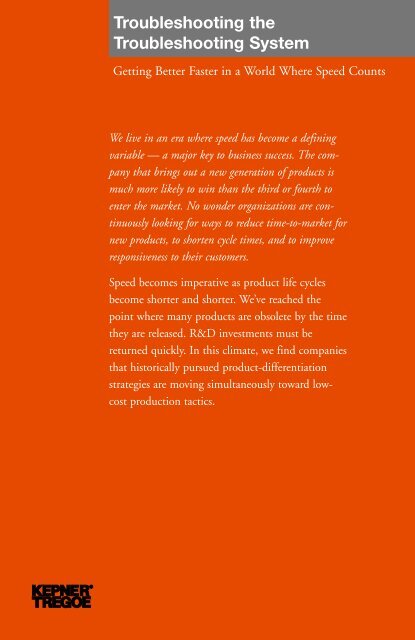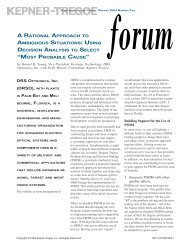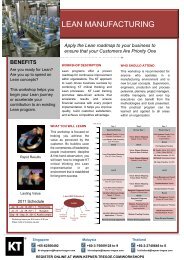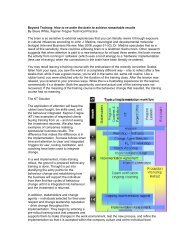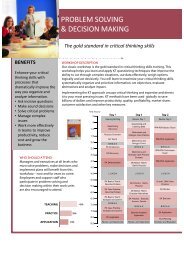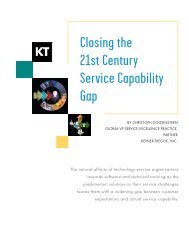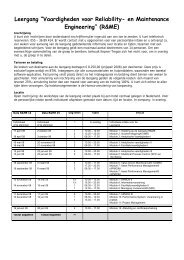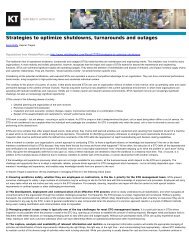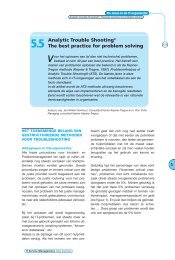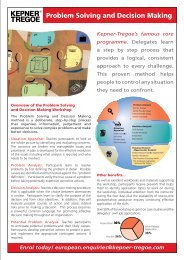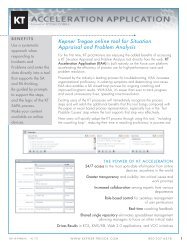Troubleshooting the Troubleshooting System - Kepner-Tregoe
Troubleshooting the Troubleshooting System - Kepner-Tregoe
Troubleshooting the Troubleshooting System - Kepner-Tregoe
You also want an ePaper? Increase the reach of your titles
YUMPU automatically turns print PDFs into web optimized ePapers that Google loves.
<strong>Troubleshooting</strong> <strong>the</strong><br />
<strong>Troubleshooting</strong> <strong>System</strong><br />
Getting Better Faster in a World Where Speed Counts<br />
We live in an era where speed has become a defining<br />
variable — a major key to business success. The company<br />
that brings out a new generation of products is<br />
much more likely to win than <strong>the</strong> third or fourth to<br />
enter <strong>the</strong> market. No wonder organizations are continuously<br />
looking for ways to reduce time-to-market for<br />
new products, to shorten cycle times, and to improve<br />
responsiveness to <strong>the</strong>ir customers.<br />
Speed becomes imperative as product life cycles<br />
become shorter and shorter. We’ve reached <strong>the</strong><br />
point where many products are obsolete by <strong>the</strong> time<br />
<strong>the</strong>y are released. R&D investments must be<br />
returned quickly. In this climate, we find companies<br />
that historically pursued product-differentiation<br />
strategies are moving simultaneously toward lowcost<br />
production tactics.
Of course, all of <strong>the</strong>se trends are fueled by <strong>the</strong> ongoing revolution<br />
in information technology. We have moved from individual<br />
productivity tools on <strong>the</strong> desktop to functional enhancements<br />
like computer-aided design and rapid prototyping and now to<br />
enterprise-wide connectivity that allows for enterprise resource<br />
planning, supply-chain integration, and e-Commerce.<br />
In this context, it is not surprising to find that more and more<br />
companies are becoming concerned with “issue resolution cycle<br />
time.” That is, shortening <strong>the</strong> time from <strong>the</strong> moment an<br />
issue — for example, a quality problem — arises to <strong>the</strong><br />
moment corrective actions have eliminated <strong>the</strong> problem and <strong>the</strong><br />
possibility of its recurrence. In o<strong>the</strong>r words, <strong>the</strong>y are recognizing<br />
<strong>the</strong> need to accelerate <strong>the</strong>ir troubleshooting.<br />
<strong>Kepner</strong>-<strong>Tregoe</strong> has identified three elements that are fundamental<br />
to building world-class troubleshooting:<br />
The troubleshooting system itself — <strong>the</strong> mechanism for coordinating<br />
problem-solving and problem-prevention activities<br />
throughout functional units and <strong>the</strong> organization as a whole<br />
Reactive and proactive troubleshooting processes — <strong>the</strong> analytical<br />
methods used for finding root cause and avoiding future<br />
problems<br />
Reusable troubleshooting knowledge — <strong>the</strong> “thought-starters,”<br />
templates, and documentation that provide a head start on<br />
recurring problems<br />
3
What Is <strong>the</strong> <strong>Troubleshooting</strong> <strong>System</strong>?<br />
An organization’s troubleshooting system is <strong>the</strong> way in which it<br />
handles <strong>the</strong> issues that need to be resolved in order to meet its<br />
operational goals and objectives. In o<strong>the</strong>r words, how it identifies<br />
issues, prioritizes <strong>the</strong>m, allocates resources for <strong>the</strong>ir resolution,<br />
tracks progress toward <strong>the</strong>ir resolution, conducts analyses,<br />
and provides recognition to those who resolve <strong>the</strong>m. The issues<br />
may be problems — for instance, scrap losses and equipment<br />
downtime; decisions — for example, selecting a new supplier or<br />
new equipment; or potential problems — such as those that<br />
tend to arise when major maintenance shutdowns are carried<br />
out or new equipment is installed.<br />
The troubleshooting system also includes <strong>the</strong> set of skills and<br />
tools that are employed to find root cause, to select appropriate<br />
corrective actions, and to prevent recurrence of <strong>the</strong> presenting<br />
problem or o<strong>the</strong>r potential problems.<br />
Typically, an organization’s troubleshooting system is informal.<br />
It’s not a clearly articulated approach governed by standard<br />
operating procedures or even organization-wide best practices.<br />
But improving <strong>the</strong> troubleshooting system — creating standard<br />
practices and building problem-prevention and problem-solving<br />
capability — pays healthy dividends. In <strong>the</strong> examples above,<br />
improving troubleshooting systems would lead to less scrap and<br />
downtime; a better, more reliable supplier or piece of equipment;<br />
and fewer implementation snarls. World-class troubleshooting<br />
systems also translate into a higher sense of<br />
achievement within <strong>the</strong> organization — a “can-do” attitude<br />
with higher employee satisfaction.<br />
Excellence in troubleshooting means that problems are not only<br />
laid to rest quickly when <strong>the</strong>y do occur, but are more often prevented<br />
from occurring in <strong>the</strong> first place. As <strong>the</strong> late quality guru<br />
4
W. Edwards Deming used to say, “If all you are doing is solving<br />
problems, you’re on <strong>the</strong> way to going out of business.” His message:<br />
reduce variation in all processes and <strong>the</strong>reby prevent problems.<br />
<strong>Troubleshooting</strong> <strong>System</strong> Components<br />
An effective troubleshooting system begins with clear standards<br />
or performance expectations that are communicated and visible.<br />
How many tons of steel are planned for this shift? How many<br />
lots of pharmaceutical production, with what anticipated yield?<br />
When standards are clear, variances quickly become evident. Of<br />
course, many minor variances can be corrected immediately, for<br />
example, with a simple machine adjustment. O<strong>the</strong>rs for which<br />
cause or corrective actions are not immediately apparent are<br />
logged locally at each production area. An effective troubleshooting<br />
system will also define how <strong>the</strong>se issues are communicated to<br />
oncoming shifts or among functions, made visible to employees,<br />
and escalated to upper management.<br />
Open issues are fed into a prioritization process. This may be at<br />
<strong>the</strong> department or plant level. Priority setting is important<br />
because most organizations do not have <strong>the</strong> resources to work<br />
on every issue at once. Those that attempt to do so often succumb<br />
to “initiative glut”: trying to make so many improvements<br />
simultaneously that resources are stretched thin and<br />
accomplishment suffers.<br />
“Vital few” management is crucial, and prioritization ensures<br />
that <strong>the</strong> organization is working on <strong>the</strong> most important problems.<br />
Resources are <strong>the</strong>n flexed toward high-priority issues, and<br />
a timetable for resolving each issue is put toge<strong>the</strong>r. Of course,<br />
priorities may change at a moment’s notice, so communication<br />
— keeping priorities visible — is vital to success. The communication<br />
medium may be electronic spreadsheets or a<br />
database on a shared network. Or tracking may merely be a<br />
5
<strong>Troubleshooting</strong> <strong>System</strong><br />
Log Issues<br />
& Prioritize<br />
whiteboard or enlarged computer printout in a central location<br />
on <strong>the</strong> production floor or in a meeting room.<br />
Once <strong>the</strong> analyses for priority issues are under way, computer<br />
systems, closed-circuit TV, or whiteboards provide <strong>the</strong> media<br />
for tracking progress. The choice of media is not as important<br />
as having information ready at hand and visible to all production<br />
personnel. Since <strong>the</strong> steps in both problem solving and<br />
problem prevention are somewhat generic, <strong>the</strong>y are easily<br />
tracked to show anticipated and actual completion dates. Once<br />
again, visibility keeps accountability and attention focused.<br />
The final component in <strong>the</strong> troubleshooting system is providing<br />
some form of recognition when issues are brought to successful<br />
completion. Many say that “what gets measured is what gets<br />
done.” But it’s more accurate to say that “what gets reinforced<br />
gets done.” Organizations have to look for ways to publicly<br />
acknowledge excellence when it occurs and to provide coaching,<br />
feedback, and appropriate sanctions when it does not. Part of<br />
recognizing that an issue has been successfully resolved is capturing<br />
good thinking and lessons learned, as well as understanding<br />
what new issues may have been raised while working on <strong>the</strong><br />
one just resolved. All of this knowledge, <strong>the</strong>n, must be fed back<br />
into <strong>the</strong> troubleshooting system to improve <strong>the</strong> results of future<br />
issue resolution.<br />
Deploy<br />
Resources<br />
Conduct<br />
<strong>Troubleshooting</strong><br />
Analysis<br />
Ultimately, success in troubleshooting depends on an organization’s<br />
analytic capability. That is, <strong>the</strong> speed at which people are<br />
able to react and find <strong>the</strong> cause of trouble when it occurs or,<br />
6<br />
Track<br />
Progress<br />
Provide<br />
Recognition<br />
for Success
etter yet, to think proactively to anticipate and prevent problems<br />
before <strong>the</strong>y happen. This is <strong>the</strong> “Conduct <strong>Troubleshooting</strong><br />
Analysis” step in <strong>the</strong> troubleshooting system, which incorporates<br />
both reactive and proactive troubleshooting.<br />
Reactive <strong>Troubleshooting</strong><br />
<strong>Kepner</strong> <strong>Tregoe</strong>’s approach to troubleshooting has both proactive<br />
and reactive elements. Whenever a variance occurs and <strong>the</strong><br />
cause is not known, it triggers <strong>the</strong> Problem Analysis process.<br />
Whenever a fire breaks out, <strong>the</strong> first order of <strong>the</strong> day is putting<br />
it out. Only after that do we turn our attention to finding its<br />
cause. Organizations that recognize trouble quickly and have<br />
<strong>the</strong> right tools at hand put problems to rest more quickly and<br />
buy <strong>the</strong>mselves time to think proactively about preventing<br />
future problems.<br />
<strong>Kepner</strong>-<strong>Tregoe</strong> suggests a five-step model for reacting to immediate<br />
problems. The first step is to delineate <strong>the</strong> precise problem<br />
you are dealing with. To simply say “fire” may result in dumping<br />
water on an electrical fire. We begin by stating <strong>the</strong> problem<br />
in terms of <strong>the</strong> specific object and its specific defect or deviation.<br />
This ensures working on one problem at a time, highlights<br />
<strong>the</strong> deviation to be contained, and targets <strong>the</strong> search for cause.<br />
The next step is thinking about interim fixes — actions such as<br />
quarantining a defective product to make sure it doesn’t get to<br />
<strong>the</strong> customer or reworking it before sending it to <strong>the</strong> next production<br />
operation.<br />
Once an interim fix is in place, <strong>the</strong> search for root cause begins.<br />
By requiring troubleshooters to first develop a rigorous description<br />
of a problem’s attributes, <strong>Kepner</strong>-<strong>Tregoe</strong>’s Problem Analysis<br />
process undercuts <strong>the</strong> natural tendency to “jump to cause” and<br />
7
Reactive <strong>Troubleshooting</strong><br />
State <strong>the</strong><br />
Problem<br />
start trying corrective actions. Testing possible causes logically,<br />
against this description, prevents costly — and ineffective —<br />
fixes from being implemented.<br />
When <strong>the</strong> true cause is known, <strong>the</strong> next step is to select appropriate<br />
corrective action. If <strong>the</strong> problem is an equipment breakdown,<br />
this may mean replacing a failed equipment component<br />
and revising <strong>the</strong> preventive maintenance schedule. But <strong>the</strong> best<br />
decision may be to replace or even eliminate <strong>the</strong> equipment.<br />
In many respects, <strong>the</strong> final step in reactive troubleshooting is<br />
<strong>the</strong> most important one. This is where purely reactive problem<br />
solving turns proactive. To prevent <strong>the</strong> recurrence of <strong>the</strong> problem,<br />
disciplined troubleshooters seek to find <strong>the</strong> cause of <strong>the</strong><br />
cause of <strong>the</strong> initial problem. They also look for o<strong>the</strong>r damage<br />
that <strong>the</strong> cause could cause. Additionally, <strong>the</strong>y want to know<br />
what o<strong>the</strong>r similar situations (equipment) may require <strong>the</strong> same<br />
corrective actions.<br />
Select and<br />
Implement<br />
Interim Fix<br />
Find and Test<br />
Root Cause<br />
Proactive <strong>Troubleshooting</strong><br />
Whenever an organization is making a planned change — new<br />
equipment, new suppliers, new products, new methods and<br />
procedures — avoiding potential problems is paramount.<br />
Unfortunately, most organizations are under such an assault of<br />
current problems that <strong>the</strong>y fail to take <strong>the</strong> time to think proactively.<br />
The <strong>Kepner</strong>-<strong>Tregoe</strong> process for safeguarding change — which<br />
may be a single action or an entire project — is called Potential<br />
Problem Analysis. It entails five major steps.<br />
8<br />
Select and<br />
Implement<br />
Corrective<br />
Action<br />
Think Beyond<br />
<strong>the</strong> Fix/<br />
Prevent<br />
Recurrence
Proactive <strong>Troubleshooting</strong><br />
Identify<br />
Potential<br />
Problem<br />
Once an action plan has been developed, a Potential Problem<br />
Analysis starts with <strong>the</strong> identification of possible difficulties at<br />
each step in <strong>the</strong> plan. The priority of <strong>the</strong>se potential problems is<br />
assessed by ascertaining <strong>the</strong> probability of <strong>the</strong>ir occurrence and <strong>the</strong><br />
seriousness of <strong>the</strong>ir effects. For major potential problems, <strong>the</strong> next<br />
step is to determine what could cause <strong>the</strong> problem. Preventive<br />
actions are <strong>the</strong>n defined and taken to eliminate, or at least reduce,<br />
<strong>the</strong> probability of this likely cause. If <strong>the</strong> probability is not driven<br />
to zero, contingent actions may also be put in place to minimize<br />
<strong>the</strong> effects should <strong>the</strong> potential problem actually occur. Finally,<br />
each contingent action requires a trigger to signal that <strong>the</strong> potential<br />
problem has occurred.<br />
To make this process a bit more concrete, let’s take as an example<br />
a major maintenance shutdown in which a company is<br />
installing a new piece of equipment while simultaneously conducting<br />
major rebuilds on o<strong>the</strong>r equipment in <strong>the</strong> area. A potential<br />
problem might be that <strong>the</strong> new equipment is not<br />
production-ready on time. A likely cause is that <strong>the</strong> disassembled<br />
equipment from <strong>the</strong> rebuild is blocking <strong>the</strong> aisle, preventing <strong>the</strong><br />
new equipment from being moved into place. A preventive action<br />
might be to begin <strong>the</strong> rebuild on <strong>the</strong> nearby equipment only after<br />
<strong>the</strong> new equipment is in place. A contingent action might be to<br />
use a crane to swing <strong>the</strong> equipment into place ra<strong>the</strong>r than towing<br />
it in on <strong>the</strong> floor. Finally, <strong>the</strong> trigger for this might be a schedule<br />
review a day or two before <strong>the</strong> new equipment is due to arrive.<br />
Identify<br />
Likely<br />
Causes<br />
Take<br />
Preventive<br />
Actions<br />
Moving an organization to proactive thinking is not easy. We all<br />
know <strong>the</strong> accolades that accrue to firefighters and <strong>the</strong> relative<br />
neglect of those who quietly prevent fires in <strong>the</strong> first place.<br />
9<br />
Plan<br />
Contingent<br />
Actions<br />
Set<br />
Triggers
Reusing <strong>Troubleshooting</strong> Knowledge<br />
To help organizations reuse knowledge gained in previous<br />
troubleshooting activities, <strong>Kepner</strong>-<strong>Tregoe</strong> has developed Process<br />
Application Kits (PAKs). Each PAK is a specific application of<br />
a <strong>Kepner</strong>-<strong>Tregoe</strong> process that provides a consistent method for<br />
handling a particular production issue.<br />
In each client situation, we help tailor a set of PAKs that detail<br />
who should use a particular <strong>Kepner</strong>-<strong>Tregoe</strong> process, when or<br />
under what circumstances, and exactly how. Each PAK delineates<br />
behaviors that become standard procedure and are incorporated<br />
into production documentation.<br />
Each PAK contains a template of “thought-starters”: decision<br />
objectives, potential problems, likely causes, and o<strong>the</strong>r contextspecific<br />
help. Organizational objectives and procedures are also<br />
built into <strong>the</strong> template. To ensure success, we also help organization<br />
leaders define <strong>the</strong>ir role in implementing and monitoring<br />
<strong>the</strong> behavior changes incorporated in each PAK. The resulting<br />
custom templates represent <strong>Kepner</strong>-<strong>Tregoe</strong>’s process and experience<br />
combined with <strong>the</strong> best of <strong>the</strong> client’s knowledge.<br />
Several PAKs based on Potential Problem Analysis help organizations<br />
manage <strong>the</strong> unexpected consequences of planned changes.<br />
Among <strong>the</strong>se are PAKs for run planning and run reviews for<br />
new or difficult products, for handling engineering change<br />
notices, and for new-equipment installation. A PAK for major<br />
maintenance shutdowns includes a template for establishing<br />
shutdown project priorities, as well as Potential Problem Analysis<br />
activities on <strong>the</strong> project plan and daily maintenance task lists.<br />
Much of <strong>the</strong> troubleshooting system outlined above, in fact, is a<br />
PAK built around <strong>Kepner</strong>-<strong>Tregoe</strong>’s Situation Appraisal process.<br />
Situation Appraisal is a systematic process for planning for <strong>the</strong><br />
resolution of complex or poorly defined concerns.<br />
10
Steps in <strong>Troubleshooting</strong> Your <strong>Troubleshooting</strong> <strong>System</strong><br />
<strong>Kepner</strong>-<strong>Tregoe</strong>’s approach to reducing troubleshooting cycle<br />
time follows <strong>the</strong> following steps:<br />
Step 1: Identify Gaps in <strong>the</strong> <strong>Troubleshooting</strong> <strong>System</strong><br />
<strong>Kepner</strong>-<strong>Tregoe</strong> helps conduct a detailed analysis of problems<br />
and how <strong>the</strong>y are currently handled. Gaps in an organization’s<br />
troubleshooting system are determined by conducting “day-in<strong>the</strong>-life<br />
studies” of people, equipment, information, and common<br />
routines and procedures. We also study problems from <strong>the</strong><br />
moment a variance is detected and reported, through shift and<br />
production meetings, to eventual resolution.<br />
Step 2: Identify Gaps in Problem-Solving and<br />
Decision-Making Skills<br />
Here we look at how actual problems are handled. What skills<br />
and tools are used, and how consistently are <strong>the</strong>y used? Is <strong>the</strong>re<br />
a common approach to problem solving or merely a free-for-all?<br />
Observations on <strong>the</strong> plant floor and in meetings yield recommendations<br />
for improving <strong>the</strong> organization’s problem-handling<br />
capability.<br />
Step 3: Design <strong>Troubleshooting</strong> <strong>System</strong>s Improvements<br />
Typically, this step entails designing and deploying some form<br />
of “issue/action register” to log issues as <strong>the</strong>y arise. Toge<strong>the</strong>r<br />
with a client implementation team, we develop shift logs, electronic<br />
spreadsheets, or databases for individual production lines,<br />
departments, and even entire sites. We also build a decision<br />
matrix for determining <strong>the</strong> priority of issues as <strong>the</strong>y arise, as<br />
well as a system for defining resources and tracking progress.<br />
Finally, we think through how to best provide problem solvers<br />
with recognition for <strong>the</strong>ir successes.<br />
11
Step 4: Provide <strong>Troubleshooting</strong> Skill Development<br />
(as needed).<br />
If employee skills are an issue — and more often than not <strong>the</strong>y<br />
are — <strong>Kepner</strong>-<strong>Tregoe</strong> prepares internal Program Leaders to<br />
transfer problem-solving and problem-prevention skills. We also<br />
provide additional training for “Process Consultants” within<br />
each department. These individuals are given <strong>the</strong> responsibility<br />
for leading troubleshooting meetings and tracking results within<br />
<strong>the</strong>ir functional area.<br />
Step 5: Install “Process Application Kits”<br />
During our analysis of <strong>the</strong> troubleshooting system, we identified<br />
activities that require <strong>the</strong> repetitive application of one or<br />
more <strong>Kepner</strong>-<strong>Tregoe</strong> processes. Working with <strong>the</strong> client implementation<br />
team, we now tailor process templates and contextspecific<br />
instructions and <strong>the</strong>n develop implementation plans.<br />
Step 6: Deploy Human Performance <strong>System</strong> Changes<br />
We help organization leaders think through <strong>the</strong>ir expectations,<br />
<strong>the</strong> signals <strong>the</strong>y send, and <strong>the</strong> feedback and consequences <strong>the</strong>y<br />
put in place to support <strong>the</strong> institutionalization of proactive and<br />
reactive troubleshooting. In total, this is <strong>the</strong> human performance<br />
system which, when designed, carefully ensures that<br />
management truly “walks <strong>the</strong> talk.”<br />
Step 7: Evaluate Project Results<br />
Establishing a clear set of measures for your results at <strong>the</strong> outset<br />
of a project makes it relatively easy to determine how successful<br />
<strong>the</strong> project has been. We assist in clarifying those measures and,<br />
as <strong>the</strong> project reaches closeout, evaluate progress, identify concerns,<br />
and build plans to ensure ongoing improvement.<br />
12
Advantages of <strong>Kepner</strong>-<strong>Tregoe</strong>’s Approach to<br />
<strong>Troubleshooting</strong> <strong>the</strong> <strong>Troubleshooting</strong> <strong>System</strong><br />
No one has said that accelerating <strong>the</strong> troubleshooting process is<br />
easy. It takes leadership commitment and persistent effort over<br />
time. But <strong>the</strong> results are well worth <strong>the</strong> investment. When our<br />
clients dedicate <strong>the</strong>mselves to excellence in troubleshooting<br />
through <strong>the</strong> institutionalization of <strong>Kepner</strong>-<strong>Tregoe</strong>’s analytical<br />
processes, <strong>the</strong>y realize significant gains on every operational<br />
measure: quality, uptime, speed, efficiency, customer delivery,<br />
and, of course, <strong>the</strong> bottom line. Our successful clients see annual<br />
reductions in actual manufacturing costs of ten percent and<br />
more <strong>the</strong> first year, and three to five percent on an ongoing basis.<br />
During a <strong>Troubleshooting</strong> <strong>the</strong> <strong>Troubleshooting</strong> Project, clients<br />
find that:<br />
We facilitate, not dictate, solutions so that in all of our work,<br />
we involve our clients. Solutions are <strong>the</strong>irs, not ours. We have<br />
found that ownership promotes <strong>the</strong> commitment to implement<br />
<strong>the</strong> change that we have arrived at toge<strong>the</strong>r.<br />
We remain involved during implementation so that we don’t<br />
produce detailed diagnostic studies that end up collecting dust.<br />
Instead, we facilitate <strong>the</strong> design of troubleshooting systems that<br />
are tailored to <strong>the</strong> client environment. And we stay with <strong>the</strong><br />
project during its implementation to ensure that our clients<br />
meet <strong>the</strong>ir business goals.<br />
Our world-class project management methodology is available<br />
to our clients as <strong>the</strong>y think through implementation issues.<br />
Highly skilled internal resources have been trained to carry <strong>the</strong><br />
troubleshooting system into <strong>the</strong> future.<br />
13
We leave behind a process for continuous improvement, so<br />
that as <strong>the</strong> organization changes <strong>the</strong> troubleshooting system and<br />
related procedures can change with it.<br />
We work closely with top management to consider <strong>the</strong> human<br />
factors associated with installing <strong>the</strong> troubleshooting system and<br />
associated analytical skills.<br />
<strong>Troubleshooting</strong> <strong>System</strong> Overview<br />
<strong>Troubleshooting</strong> <strong>System</strong><br />
Log Issues<br />
& Prioritize<br />
Deploy<br />
Resources<br />
Reactive <strong>Troubleshooting</strong><br />
State <strong>the</strong><br />
Problem<br />
Proactive <strong>Troubleshooting</strong><br />
Identify<br />
Potential<br />
Problem<br />
Select and<br />
Implement<br />
Interim Fix<br />
Identify<br />
Likely<br />
Causes<br />
Conduct<br />
<strong>Troubleshooting</strong><br />
Analysis<br />
Find and Test<br />
Root Cause<br />
Take<br />
Preventive<br />
Actions<br />
14<br />
Track<br />
Progress<br />
Select and<br />
Implement<br />
Corrective<br />
Action<br />
Plan<br />
Contingent<br />
Actions<br />
Provide<br />
Recognition<br />
for Success<br />
Think Beyond<br />
<strong>the</strong> Fix/<br />
Prevent<br />
Recurrence<br />
Set<br />
Triggers
<strong>Kepner</strong>-<strong>Tregoe</strong> at a Glance<br />
<strong>Kepner</strong>-<strong>Tregoe</strong> has earned a worldwide reputation for improving<br />
business results through people.<br />
A global leader in effecting successful change and improvement,<br />
<strong>Kepner</strong>-<strong>Tregoe</strong> helps its clients achieve lasting results through a<br />
proven approach of Process, Facilitation, and Transfer.<br />
Focusing on <strong>the</strong> needs of <strong>the</strong> organization’s people — <strong>the</strong>ir<br />
skills, capabilities, and performance environment — <strong>Kepner</strong>-<br />
<strong>Tregoe</strong> continues to find innovative ways to integrate human<br />
resources into an organization’s strategy, structure, and systems,<br />
and <strong>the</strong> processes by which its goals are accomplished.<br />
Working across boundaries, at every level of <strong>the</strong> organization,<br />
<strong>Kepner</strong>-<strong>Tregoe</strong> provides common processes and methodologies<br />
to implement successful change initiatives.<br />
Through its focus on <strong>the</strong> human side of change, <strong>Kepner</strong>-<strong>Tregoe</strong><br />
helps clients achieve a real and sustainable competitive advantage,<br />
one based on <strong>the</strong> collective knowledge, skills, and capabilities of<br />
<strong>the</strong>ir people.<br />
15
PLEASE VISIT US ON THE INTERNET AT WWW.KEPNER-TREGOE.COM<br />
HEADQUARTERS UNITED STATES<br />
<strong>Kepner</strong>-<strong>Tregoe</strong>, Inc.<br />
P.O. Box 704<br />
Princeton, New Jersey 08542<br />
609-921-2806<br />
Fax 609-497-0130<br />
AUSTRALIA<br />
<strong>Kepner</strong>-<strong>Tregoe</strong> Australasia<br />
Level 8<br />
50 Berry Street<br />
North Sydney, NSW 2060<br />
Australia<br />
61-2-9955-5944<br />
Fax 61-2-9955-1625<br />
CANADA<br />
<strong>Kepner</strong>-<strong>Tregoe</strong> Associates, Ltd.<br />
45 Sheppard Avenue, East<br />
Suite 305<br />
North York, Ontario<br />
M2N 5W9<br />
416-221-5522<br />
Fax 416-221-9376<br />
FRANCE<br />
<strong>Kepner</strong>-<strong>Tregoe</strong> Sàrl<br />
91, rue du Faubourg St-Honoré<br />
F-75370 Paris, Cedex 08<br />
+33-(0)1.44.71.36.05<br />
Fax +33-(0)1.44.71.35.72<br />
GERMANY<br />
<strong>Kepner</strong>-<strong>Tregoe</strong> Deutschland<br />
An der Alster 17<br />
D 20099 Hamburg<br />
Germany<br />
49-40-28 40 75-0<br />
Fax 49-40-28 40 75-28<br />
HONG KONG<br />
<strong>Kepner</strong>-<strong>Tregoe</strong><br />
4th Floor, Dina House<br />
Ruttonjee Centre<br />
11, Duddell Street, Central<br />
Hong Kong<br />
852-532-8348<br />
Fax 852-845-3485<br />
IRELAND<br />
<strong>Kepner</strong> <strong>Tregoe</strong> Ireland Ltd<br />
Orania House<br />
97 St. Stephens’ Green<br />
Dublin 2<br />
Republic of Ireland<br />
+353/1/2834030<br />
Fax +353/1/2836230<br />
JAPAN<br />
<strong>Kepner</strong>-<strong>Tregoe</strong> Japan<br />
Moto-Akasaka Kikutei Bldg.<br />
7-18 Moto-Akasaka 1-chome<br />
Minato-ku, Tokyo, Japan 107<br />
81-3-3401-9521<br />
Fax 81-3-3479-0745<br />
MALAYSIA<br />
<strong>Kepner</strong>-<strong>Tregoe</strong> (M) Sdn. Bhd.<br />
Unit 607, Block D<br />
Phileo Damansara 1<br />
No. 9, Jalan 16/11<br />
Off Jalan Damansara<br />
46350 Petaling Jaya<br />
Malaysia<br />
60-3-460-9128<br />
Fax 60-3-460-9138<br />
SINGAPORE<br />
<strong>Kepner</strong>-<strong>Tregoe</strong>,<br />
Sou<strong>the</strong>ast Asia, Ltd.<br />
18-06 United Square<br />
101 Thomson Road<br />
Singapore 307591<br />
65-256-6494<br />
Fax 65-256-6500<br />
SWITZERLAND<br />
<strong>Troubleshooting</strong> <strong>the</strong> <strong>Troubleshooting</strong> <strong>System</strong> is a Publication of <strong>Kepner</strong>-<strong>Tregoe</strong>, Inc., P.O. Box 704, Princeton, NJ 08542<br />
(609) 921-2806. Copyright © 1999 <strong>Kepner</strong>-<strong>Tregoe</strong>, Inc. All Rights Reserved.<br />
700-10-P175899 KL480. 003664<br />
(Serving Belgium)<br />
<strong>Kepner</strong>-<strong>Tregoe</strong>, S.A.<br />
Rue de la Porcelaine 13<br />
B.P. 90<br />
CH-1260 Nyon 1<br />
+41-(0)22-361.21.31<br />
Fax +41-(0)22-362.12.81<br />
THAILAND<br />
<strong>Kepner</strong>-<strong>Tregoe</strong><br />
(Thailand) Inc., Ltd.<br />
10th Floor<br />
Thosapol Land Building 2<br />
230 Rajchadaphisaek Road<br />
Huaykwang, Bangkok 10320<br />
Thailand<br />
66-2-274-0646<br />
Fax 66-2-274-0728<br />
UNITED KINGDOM<br />
<strong>Kepner</strong>-<strong>Tregoe</strong> Ltd.<br />
Bentley House<br />
13-15 Victoria Street<br />
Windsor<br />
Berkshire SL4 1HB<br />
England<br />
44-1753-856716<br />
Fax 44-1753-854929<br />
AFFILIATES<br />
Brazil<br />
Czech Republic<br />
Denmark<br />
Finland<br />
Italy<br />
Korea<br />
Mexico<br />
Ne<strong>the</strong>rlands<br />
Philippines<br />
Poland<br />
Spain<br />
Sweden<br />
Venezuela


